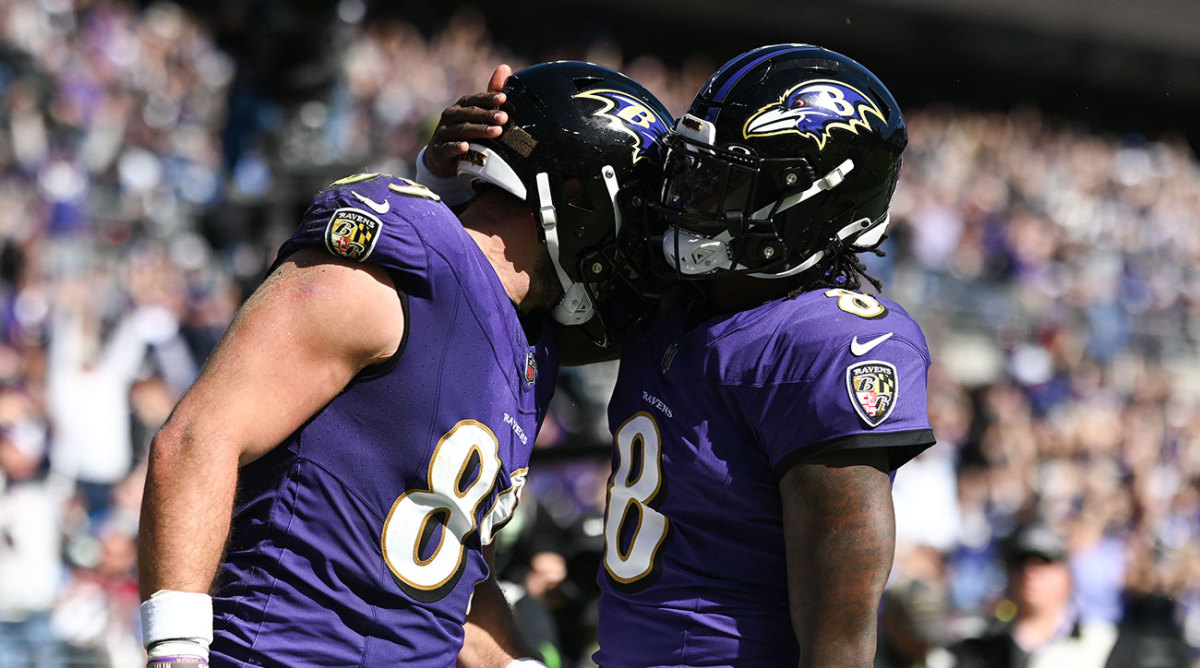Why Lamar Jackson Looks More Dangerous Than Ever

The Ravens stomped the Lions 38–6 Sunday, in a game that should not force us into any grand conclusions about Detroit. The Lions had a bad day, just a week after some of their strongest run concepts were stymied by a very good Buccaneers defense which, when compounded by the loss of their most experienced running back (David Montgomery), is forcing the team into some serious readjustments at a time when they are vulnerable.
In those weeks, Baltimore is one of the worst teams to play. The Ravens bring pressure in a way that is almost unnerving for even the best offenses. The old football axiom about “pinning one’s ears back” when ahead and in obvious passing downs looks one way for most of the NFL. When Baltimore pins its ears back, the team looks like a UFC fighter attacking a lay person at Target.
What can we say with confidence after a week like this? Let’s focus on Lamar Jackson, who threw just six incompletions, chucked three touchdowns and ran for another. I think there is little doubt that the quarterback we were promised, with a new system under OC Todd Monken, with new receivers, with a new contract, has arrived. The sample size is there, now seven games into the season. Jackson may be just as unpredictable from a sustainability standpoint—even though I think he has more options than he ever has at this point in his career, he is rushing at almost the exact same clip, with one more attempt through the first six weeks of the season as he did a year ago. But as a player in command of the game and in command of the pocket there is little doubt that he has evolved.

Jackson is getting rid of the ball, on average, about 0.02 seconds per snap faster. Last year, he averaged three seconds per drop back, according to NFL Next Gen Stats, which placed him in dubious company, along with Justin Fields, Sam Darnold, Zach Wilson, Kenny Pickett and Russell Wilson. This year, he is closer to the middle of the pack, around Justin Herbert, Derek Carr and Baker Mayfield. If that feels insignificant, watch an elite NFL pass rusher track into the backfield and tell me how much more valuable that blink of an eye is for your long-term health and safety.
Jackson is also throwing a lot fewer bad passes. Pro Football Reference tracks less-than-ideal throws and compiles a bad throw percentage. Through six games a year ago, about one in five of Jackson’s passes were ill-advised. This year, the number is closer to one in every 10.
It leads to more downs like one we saw early in the fourth quarter against the Lions on Sunday. It was nothing spectacular, but on a first-and-10 throw to Odell Beckham Jr, Jackson’s back heel hit the turf for a second time after he received the snap and the ball was gone. A flurry of wide receivers and tight ends ran routes in such a way that spaced Beckham just beyond the reach of a pair of zone defenders. Jackson, doing something he did at Louisville (and had to, for some reason, promise every anonymous NFL executive he could do in the professional ranks again) fired a fastball for an easy first down.
Jackson has a very accurate fastball, which may not have been as obvious to us when, in half of Baltimore’s games, he was throwing at a clip of less than 60% accuracy. This year, Jackson hit more than 70% in five of six games, and then 77% against the Lions.
Rhythm is everything to a passer, and, God bless him, Jackson did a lot earlier in his career without a great deal of rhythm. As the nerve center of Baltimore’s run game, he was tied into, and almost expected, to spend most of the passing downs evading and allowing an injured and slower (tight end-heavy) receiving corps to get open. He was like a volley tennis player, who succeeded mostly by wearing out the opponent through continuous attrition.
Now, he is on pace to throw fewer balls off play-action and off run-pass-option concepts, according to Pro Football Reference. It is more of what one quarterbacks coach told me about Jackson a few years ago: If Jackson could find a way to make every snap look the same, to have his feet down on time and to have the ball come out when it is supposed to, he could be dominant.
During the broadcast Sunday, Fox analyst Greg Olsen, a longtime teammate of Cam Newton, talked about the double-edged sword of good mobile quarterbacks. There is always a pressure to use all of their athletic talents, even if a few of them are deleterious to their overall health.
Newton could never quite get there. Jackson, as a Heisman Trophy winner with back-to-back seasons of a passer rating nearing 150 before he left college, was there to a degree before he was strategically misinterpreted, or perhaps, underestimated for the sake of efficiency. Now, he is more accurate than ever. He looks more comfortable than ever. And, because of that, we can safely suggest that he is more dangerous than ever.
